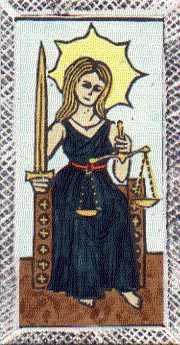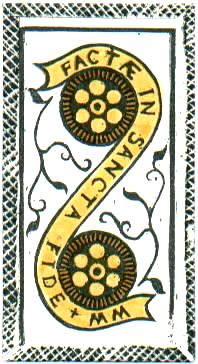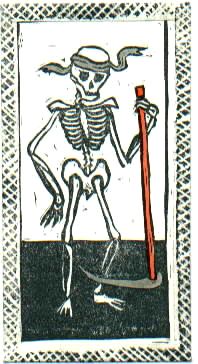|
Navigation |
|
|
|
Back Design. The crisscross border is folded around to the front of the card, so only appears half as wide on a finished card as it does in this scan. The design shows a typical medieval cosmographic scheme, with the four elements at the bottom, the celestial spheres in the middle, and Heaven at top. |
|
|
Ace of Batons * As di Bastoni The “Latin” suits of batons, cups, swords, and coins were features of ordinary playing cards when the first appeared in Europe in the 14th century. The tarot deck simply continued these standard symbols, which are still found in Italian and Spanish playing cards today. Designs for the ace of batons (and the ace of swords) showing it being presented by a divine hand emerging from a cloud are also quite ancient. The crown is also a common feature. Banners displaying mottoes or sayings were also widespread, and I have chosen the Latin word “vis”, meaning force or will, to express the symbolism of the card. A baton or rod is a symbol of authority and personal power. |
|
|
Love * L’Amore The card known to modern tarot users as “The Lovers” was originally entitled simply “Love”. As such, it represents love as a force in human life. In Petrarch’s poem I Trionfi, love conquers all mortals, including the wise and powerful. The placement of this card in most traditional orderings (immediately following the Pope as the highest human authority) reinforces this idea. Cupid or Eros hovers above the young couple, arrow poised. Unlike the Tarot de Marseille and other later tarot designs, this image does not show a young man choosing between two women. Instead, this design (liberally adapted from the Cary-Yale Visconti deck, probably dating from before 1450), emphasizes the union between the two people, suggesting a betrothal or marriage ceremony. |
|
|
3 Swords * 3 Spadi In old playing cards, swords are usually drawn as curved. Cards originally came to Europe from the Islamic world, which was of course known for its curving scimitars. The design also served a practical function, making swords easy to distinguish from batons at a glance. (Early cards had no corner indices to identify them.) When an odd number of swords is present, the final one is often drawn straight, piercing the design created by the curved pairs. Symbolically, this suggests a decisive thrust that breaks a stalemate. The three of swords might thus signify a decisive, perhaps aggressive or painful, resolution to a dilemma. |
|
|
The Sun * Il Sole All manner of different designs were used for the Sun card in early tarot decks. The two children of the Tarot de Marseille is an astrological reference, often used to signify the Sun and its house. Other decks show the Sun being carried across the sky, a courting couple, Alexander and Diogenes, or simply a stylized sun symbol. It is interesting that almost all of these designs feature two human figures in some way. Rather than choosing among these different early designs, I used an entirely different image, but one that echoes many of the others. The design is based on a sixteenth-century model with alchemical overtones. The aged sun king and the young boy represent the cycle of age, death, and rebirth. The Sun is also the cosmic manifestation of the masculine principle, just as the Moon manifests the feminine. As a very high ranking card, the Sun resides in the upper echelons of the powers of the cosmos. |
|
|
2 Batons * 2 Bastoni When playing cards entered Europe from Islam, the suits were coins, cups, swords, and polo sticks. The latter were unfamiliar to Europeans, who interpreted them as batons. In Italy, the batons were usually depicted as smooth rods with decorated ends. In Spain and Portugal, they became rough cudgels. Two is the number of choice, balance, contrast, and complementation. Taking batons as a symbol of personal authority, the 2 crossed batons on the card may be interpreted as conflicting intentions, a stalemate, or a collaboration between equally strong-willed individuals. It may also represent a tentative balance between two aspects of one’s personal identity. |
|
|
9 Batons * 9 Bastoni When a large number of suit symbols are depicted on a card, the ingenuity of the designer is pressed to its limits. Without corner indices, the user of the cards must be able to identify the suit symbol and numerical rank from a glance at the card face. Batons were conventionally arrayed as a symmetrical criss-cross lattice (woven in a way that would be impossible for actual rods). For odd numbers, the extra baton was inserted vertically through the lattice. This design suggests a symbolic interpretation. The eight batons form a dense network, almost a cage or fence, a barrier to motion and change. The ninth baton seems desperate to break out of the pattern it is woven into. The card can thus be taken to represent a heroic effort against powerful, unrelenting resistance. |
|
|
Justice * La Justicia Justice is one of the cardinal virtues of antiquity that is represented in the tarot. (The other two are Fortitude and Temperance; Prudence is mysteriously absent.) Justice is personified as a female figure with sword and scales, still recognizable to us today as a symbol of jurisprudence. In this design, as in a number of old decks, she is shown with a halo. Justice is the virtue that presides over the interactions between people in society. Justice requires fairness, a perfect balance between one’s own wants and those of others. She finds the balance between selfishness and self-denial (which appear in the tarot as the Chariot and Love, respectively). Although justice is the patron of public law, she also presides over private personal conduct. |
|
|
The Fool * Il Matto The Fool stands alone; neither a trump card nor a suit card, but an outsider. In the game of triumphs, the Fool can be played at any time as an “excuse”, and though it cannot take any other cards, neither can it be taken, so the player retains the large point value assigned to the card. As in the game, so also in life and art, the Fool is an outsider, perhaps homeless and wretched, perhaps mad, perhaps a vagabond entertainer beholden to no one. The design of this card is a blending of three early Fool cards: the Visconti-Sforza, the Tarocchi del Mantegna, and the early Tarot de Marseille. The feathers in his hair symbolize folly. The dog nipping at his leg suggests the Fool’s lowly station, as does his ragged tunic. The Fool embodies many paradoxes: naïveté and wit, folly and wisdom, debasement and holiness. His simplicity exempts him from all judgment and from all dictates of custom. |
|
|
2 Coins * 2 Denari The two of coins, especially in decks of the Marseilles family, often bears a scroll giving the name of the cardmaker, perhaps with place and date as well. (One remarkable early example of this practice is a card found at the Sforza castle, plainly date 1499.) The decision to preserve this old custom presented an interesting design challenge, as the Cartae Triumphorum is a modern creation intended to give the illusion of antiquity. I opted for a Latin motto, “factae in sancta fide”, signifying “made in Santa Fe”, but which can also be read “made in holy faith”, a statement that would not be entirely out of place on a 15th-century Italian card. Coins are the suit of wealth, good fortune, and the merchant class. With 2 being the number of balance and alternatives, the 2 of coins may naturally suggest a financial crossroads or a juggling of commitments. |
|
|
8 Swords * 8 Spadi The high-numbered cards of batons and swords are geometrically complex and difficult to design so that the suit symbols are pleasingly arranged but still easily counted. The curved swords, unlike the straight batons, intersect in two places, creating two diamond-shaped lattices in the design. Symbolically, swords obviously represent violence and conflict, but also elitism, sophistication, nobility, and knightly discipline and etiquette. Hence swords cards are often cards of conflict concealed behind politics or professionalism. The eight of swords depicts a perfect impasse or stalemate between heavily armed parties or opinions. The swords make a completely impenetrable cage; the floral emblem in the center seems quite helpless and almost superfluous. |
|
|
Death * Il Morte Even people who know nothing else about tarot know this card, which is presumed to foretell literal death. Fears and superstitions surrounding the card apparently go back a long way—even when titles began to be printed on the cards with the early Tarot de Marseille decks, Death was left untitled. In all the variant orderings of the tarot trumps, Death was without exception given the number 13. Ironically, though, when the cards first appeared in the early 15th century, the skeletal figure of Death probably did not stand out so much. Europe had suffered through a century of the Black Death, and imagery of the danse macabre, in which the skeleton is seen cavorting indiscriminately with paupers, kings, and clergy, was ubiquitous. In Florence, an elaborate “Triumph of Death” was staged annually in the city center. Death was thus a natural subject for the series of triumphs, vanquishing the lower cards depicting life’s aspirations, but itself subject to the greater cosmic powers, such as the Devil, celestial lights, and God. |
|
Copyright © 2000-2008 Tom Waters |











